
For the most part, however, much larger quanities of coins were needed. Because of the scarcity of coins, especially in the remote areas, the colonists sometimes used other mediums of exchange, such as bullets, mussel shells (called wampum) and animal skins. Unfortunately, for the early American settlers, our mother country, England, failed to consider the coinage problems mounting in her colonies abroad. Since the English Parliament evidently was not going to provide more coins for the hard pressed colonists, some of the more industrious Americans opted to take matters into thier own hands. Whether or not they had the authority to do so, the General Court of Massachusetts Bay Colony granted John Hull permission to begin minting coins. Hull set up a mint in Boston and began producing the well known New Engalnd Pine Tree Coins in 1652, the demoninations being threepence, sixpence and one shilling. These were the first coins minted in the New World, outside of Mexico.
As time went on, other coins and tokens of various types were introduced and used by the colonists regularly. After the Revolutionary War broke out, there was little change in the patter of coins circulating in America. To be sure, there were new pieces always entering from abroad, as usual, which were quickly accepted in the coin starved colonies. It was during the first unified currency system was established which consisted of notes issued by the Continental Congress to finance the Revolution. Although these notes were originally declared to be redeemable after the war in gold and silver coins, it was found impossible because of the excess of printed notes over metal reserves. Consequently, the notes depreciated in value rapidly and became worthless. Thomas Jefferson, in 1784, recommended the use of the decimal system with the dollar as the basic unit of trade: and on July 6, 1785, the United States Congress voted in favor of Jefferson's plan. However, it was not until after the Constitution was implemented and George Washington was sworn in as our first President, that COngress turned its attention to solving the "money mess" by beginning to establish our national coinage system as it is known today.
On April 2, 1792, Congree approved a law allowing coins to be minted bearing the words "United States of America". This was the first major step in establishing out national coinage system. President Washington appointed a famous scientist and philosopher named David Rittenhous to be the first Director of the Mint. Construction of the facility, located in Philadelphia, began in Summer of 1792. The coin demoninations specified in the 1792 coin law were as follows:
Because the minting process was primative by today's standards, some of the early Unites States coins bear file marks, a result of weight adjustments made by the mint's original employees. For many years after the Philadelphia Mint began operating, coins failed to appear in sufficient numbers throughout the United States. The problem did not arise because of the mint's inablity to produce money in adaquate volumes. The expected movement of new coinage into the channels of trade was greatly impaired by metals specualtors, who exported overseas as many gold and silver coins as they could obtain. The reason for one way flow was the weight ratios between American and forign currency: the bullion value of American coins caused them to find thier way to foreign markets for sale and melting. It was not until 1834 that Congress reduced the weight standard of gold, a move which helped to alleviate the exportation of American coins. The passage of another in 1837 to further revise and standardize the mint and coinage laws proved beneficial to the American Nation. More Congressional Legislation in 1853 reduced the weight of silver coins by 7%, to make the metal volume less than face value, causing smaller coins to be retained in circulation as the number of United States coins decreased. In fact, Congress enacted a law in 1857 to prohibit the continued use of foreign and private coins. When the Philadelphia Mint began operation in 1793, it thought that it would fulfill the coinage demands of our new nation. Within forty years, however, pioneers had extended the American frontier so far from Philadelphia the mint could no longer serve the needs of our growing nation. To meet the needs of the growing country, several branch mints were opened the first being in 1838. To distinguish the place of origin, small letters, or "mint-marks" were added to the coins' surface, differentiating one mint from another. A rundown of all United States mints that saw active duty follows below.

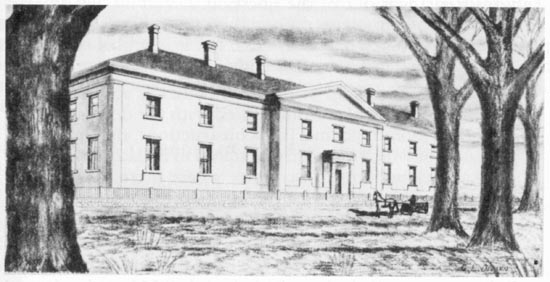
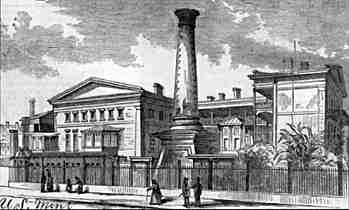


The discovery of silver at Nevada's famous Comstock Lode brought another westward migration of fortune seekers. Although established perhaps because of political pressure from the powerful mining companies, the Carson City Mint produced some of the most highly prized coins in today's market, due to the scarcity and allure of owning an artifact from the "Wild West". The Carson City Mint passed into oblivion for several reasons: the glitter of silver eventually dimmed, the overabundance of coins available to the local economy and because the Mint was unable to cleanse its reputation following a government scandal resulting in the suspension of the Mint from 1886-1888. From 1893-1933, the Carson City facility operated as an assay office. In time, the old mint became the Nevada State Museum, where visitors will find an exibit dedicated to the building's original purpose, as well as view pristine examples of the rarest Carson City coins which are well out of the reach of average collectors.
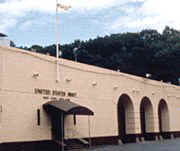
Originally, the West Point Bullion Depository was erected in 1937 as a storage facility for silver bullion and was nicknamed "The Fort Knox of Silver." From 1973 to 1986, West Point produced cents, and in 1980 began striking gold medallions. Shortly afterward, approximately 20 billion dollars worth of gold was stored in its vaults, making it second only to Fort Knox for gold storage. Today, it is also the major producer of gold coins. March 31, 1988 was the date when the American Mint at West Point gained official status as a U.S. Mint. Today it is still a storage facility, but also manufactures, packages and ships gold and silver commemorative coins, and American Eagle Bullion coins in proof and uncirculated condition. Its Platinum Eagles have been very popular since their first issuance in 1997. In 2000, it struck the first ever Gold and Platinum Bi-Metallic Coin. Today American Eagle Gold Bullion Coins are minted to demand in West Point, New York, located near the U.S. Military Academy. The West Point Mint manufactures the entire family of American Eagle proof and uncirculated coins in gold, silver, and platinum. Gold and platinum coins are manufactured in denominations of one-ounce, half-ounce, quarter-ounce and tenth -ounce. Silver bullion coins are manufactured in one-ounce denomination. No public tours of this facilty are available due to its extremely high security.

In operation 1792 to the present. Today the largest and most modern mint facility in the world spanning five acres under roof, the facility creates all dies for Unites States coins and sends them to the branch mints. The forth and present mint was dedicated in 1969, just a short walk from the original 1792 building.

Interestingly, no silver dollars bearing the date 1804 were actually minted in that year. All silver dollars bearing the date 1804 were in fact produced by the U.S. Mint in 1834 and in the 1850's and none were ever intended for general circulation. Why did this occur?
After 1800, the price of silver rose dramatically and silver dollars slowly began to disappear from general circulation. Large quantities of U.S. silver dollars were exported outside the country or melted down for their high intrinsic silver content value. Because of this, the U.S. government decided at the end of 1803 to cease production of silver dollars. No silver dollars were produced beyond early 1804 by the US Mint and those few that were minted in that year from leftover dies all bear the date 1803.
In 1834 several presentation sets of U.S. coins were required for diplomatic gifts. A silver dollar dated 1804 was minted for inclusion in these presentation sets since that was the last year the dollar coin was authorized to be produced. These dollar coins are referred to as "original" or Class I 1804 dollars. It is thought that as many as 10 of these coins were produced for presentation to the King of Siam (now Thailand) and the Imam of Muscat. However only 8 genuine specimens are known to exist.
In the late 1850's a few more examples of the 1804 were produced for foreign dignitaries and are known as Class II specimens, today only one Class II coin is known to survive and is in the Smithsonian Institute.
The mid 1870's saw yet another handful of 1804 Bust Dollars, known as Class III examples, struck for presentation to prominent numismatists of that time period. It is unknown how many of the Class III were struck however only 6 specimens of this type are known to exist.
Because of its great rarity and value, 1804 dollars have been widely counterfeited and some of the fake coins were considered to be genuine for a considerable period of time.
The condition or grades of the 1804 dollars known to exist range from Extra-Fine to Choice Uncirculated with the Eliasberg specimen graded at Proof 60. There are also a few specimens that have been improperly cleaned and as a result toned almost black, thus greatly reducing their grade.
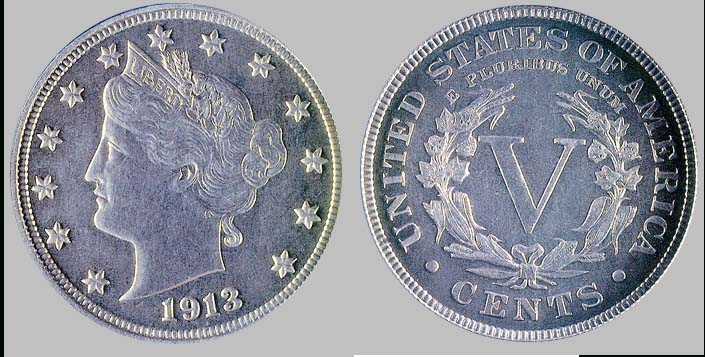
Supposedly, Mr. Samuel W. Brown, Assistant Curator of the Mint Cabinet Collections and previously, Clerk or Storekeeper of the Mint, decided to have some late night coining activity done for unscrupulous reasons. The fact known is that he was the first to advertise in numismatic publications to buy any 1913 Liberty Head Nickels. He put an advertisement in The Numismatist in December of 1919 offering to pay $500 per coin. It sounds pretty logical to me that he simply waited until the "right" people either died, retired or whatever, to make his move in "making a market". But this is just speculation. Basically, that is everyone's speculation.
Anyway, years later the megalacoindealer of his time, B. Max Mehl of Fort Worth, Texas, advertised to pay $50 a piece for 1913 Liberty Head Nickels. According to Breen, Mehl later admitted spending over a million 1930's Depression Era dollars for the nationwide advertising campaign. The ads weren't actually expected to bring any sellers to him as he knew that only a few had been struck. The guy was a marketing guru in numismatics for his day. The stimulus for the rare coin market was terrific. People were checking their pocket change. Rare coins were (and are) occassionally found in pocket change, abandoned buildings, buried in the ground, etc.. B. Max Mehl meanwhile, was busy selling his Star Rare Coin Encyclopedia like hotcakes.
Some pretty colorful characters have owned these nickels. From King Farouk, the Egyptian King (and playboy) to a vest-pocket dealer by the name of J.V. McDermott. Old timers say McDermott did most of his business across the bar. He used to pass it around for folks to admire, figuring it was too important and rare to "just walk off". Where would you unload it without attracting attention?
This is a coin of extreme popularity and value. As a matter of fact, a 1913 Liberty Head Nickel appeared in an old episode of the television program Hawaii Five-O and more recently in an episode of Early Edition.
Owners: Samuel W. Brown, Stephen K. Nagy, Wayte Raymond, Col. EHR Green, Burdett Johnson, Eric P. Newman, Abe Kosoff, Louis E. Eliasberg, Sr., and Jay Parrino.

The Liberty or Barber Dime as it is known was first minted in January of 1892. In 1894 24 coins were produced by the San Francisco Mint even though the mint has no records of striking any Barber Dimes in that year. It is widely believed that the mint director had the coins struck secretly as presentation pieces for himself and other prominent collectors of the era. Of the 24 coins produced only 9 are known to exist today.
All of the 9 known examples of the 1894-S dime have been tracked back to creation at the Mint with varying degrees of success. In David Lawrence's 1991 book, The Complete Guide to Barber Dimes, he identified 10 known specimens, one of which has been "de-listed" since its existence cannot be confirmed. The "Lawrence" numbering system has been used to identify each coin. (Note: Lawrence-4 has been de-listed in 1991 because its existence is considered doubtful.)
| $145,000 | Noticeable spot on Liberty's chin, obverse shows signs of being harshly cleaned | |||
| Mostly brilliant centers changing to delicate gold at the borders. A tiny lint mark from neck to below chin will serve to identify this specimen | ||||
| Rose, blue and steel toning. The finest of all the 1894-S dimes | ||||
| Brilliant proof with some minor toning | ||||
| Reverse has a vertical scratch and what appears to be a planchet flaw on the lower right, extending into the mint mark | ||||
| Has a significant mark on Liberty's cheek. Maple leaf below 'D' is weakly struck. Faint vertical striations on the reverse. Light lilac and gray toning over gold surfaces | ||||
| Coin has considerable flaws due to being mishandled, would not certify at PCGS or NCG | ||||
| Old reverse scratch through 'ONE DIME' plus some other light circulation marks on the obverse. Although referred to as the 'Ice Cream Shop' Specimen, there is no actual proof to show this is the dime Hallie Daggatt spent | ||||
| Circular cut on the obverse | ||||

Called the "King of Morgan Dollars", the 1895 is one of the most desirable and sought-after dates in the series. Although Mint records indicate a mintage of 12,000 circulation strikes, of that number experts believe that only 880 were Proofs. The existence of several circulated examples confuses the issue, but those are believed to have been Proofs that were spent inadvertently. Ownership of this popular rarity is the true measure of completeness for a collection of Morgan Dollars - the 1895 Proof is the only real "stopper" in the series. Of that 880 original strikes it is believed that only about a quarter of that number survive today due to the excessive melting of silver coins, especially Morgan Dollars, by the mint in 1921. Before they were recognized as the stopper of the Morgan collection, examples were being sold for as low as $10.00 a coin in turn of the century coin shops. It was not up until after World War II that the coins gained the status and value they have today, with any example whether it be AG - Proof 65 will fetch prices in the high thousands and is out of reach for most collectors.

The original Saint-Gaudens Double Eagle design was cut into the dies in such high relief that, with the first issues intended for circulation, it took four or more blows from the coin press to fully bring out all the details. The engravers at the Philadelphia Mint, particularly the jealous Chief Engraver, Charles E. Barber, objected vigorously to the new design and sought to have it modified or eliminated altogether.
Despite these difficulties, President Roosevelt ordered the Mint to "begin the new issue even if it takes you one day to strike one piece!" This did not end the problems, however. Bankers complained that these high relief Double Eagles did not stack well, while the high relief design was unpopular with the staff of the Mint because it did not lend itself well to mass production.
Because of their great beauty, most of these coins were kept as souvenirs and never reached circulation. In fact, these coins immediately sold for a premium over face value, with examples bringing $25 to $30 soon after issue. Only 11,250 of these High Relief Double Eagles were minted before the design relief was lowered to facilitate mass production. The beauty and rarity of the high relief Double Eagle made it one of the most sought after of all gold coins with uncirculated and proof examples ranging in price from $20,000 - $200,000.
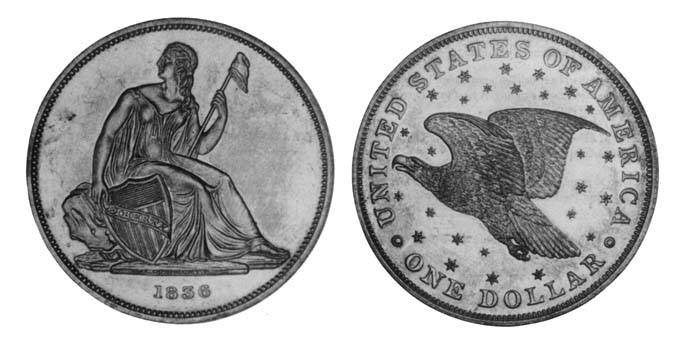
The United States Mint had ceased striking silver dollars in 1804. Although the denomination was the "flagship" monetary unit in U.S. coinage, demand for it came mostly from bullion depositors, and few dollar coins circulated in the beginning of the 19th century. Much of each year's mintage was either melted domestically or exported.
By the 1820s and 30s however, two successive Mint directors, Samuel Moore and Robert M. Patterson, had advocated reviving dollar coinage. Although Moore obtained authorization to do so in 1831, it wasn't until Patterson replaced him in 1835 that preparations finally got under way. Not since the 1792 half dismes were struck had so many Mint and other government officials taken such a keen interest in the production of a new coin.
Mint Director Patterson, ambitious to make an artistic statement, hired artist Thomas Sully to make sketches of a full figure of Liberty - along the lines of the allegorical figure Britannia seen on English coins. Patterson retained noted painter Titian Peale to fashion the eagle for the reverse and instructed newly hired Second Engraver Christian Gobrecht to translate the designs to metal. Gobrecht's design was a composite of both Peale's and Sully's works, as well as his own ideas. It was a masterful work and received immediate acclaim. President Jackson and his Cabinet reviewed Gobrecht's sketches on October 17, 1835 and were favorably impressed.
The final design featured the figure of Liberty seated on a rock, draped in a loose-fitting gown—suggesting statuary from Hellenistic Greece. She is looking over her right shoulder, her right arm supporting the Union shield. Her left arm holds a long pole with a Liberty cap on top. The entire central device stands alone on the obverse with no stars or lettered devices, only the date below, giving the coin a medallic quality, with Liberty a solitary, cameo figure. A naturalistic eagle in flight adorns the reverse, the bird rising "onward and upward" as Patterson ordered, a position intended to symbolize the unbounded optimism that Americans had for the nation's future. The eagle flies amid a field of 26 large and small stars, representing the thirteen original states and the thirteen admitted to the Union since 1789 (anticipating Michigan's entry).
By November, 1836 all was ready for trial strikings in silver. A small number, presumably 18 pieces, of the new dollars were distributed in Philadelphia. Reaction was almost universally positive, with one exception. Patterson had ordered Gobrecht to place his name on the new coin. He did so by inscribing C. GOBRECHT F. in small letters in the field beneath the figure of Liberty—the 'F.' standing for FECIT, Latin for "He made it." Gobrecht was criticized as a "conceited German" and vilified in the local press. Patterson solved the problem by having Gobrecht move his name to the base of the figure of Liberty, visible only if one looks carefully at the coin. The eighteen or so pieces struck with his name below the base are considered patterns and are very rare.
Regular production of Gobrecht dollars began sometime in December of 1836. The 1,000 regular issue dollars of 1836 were struck at the old 1792 standard fineness of .8924. The same date was used for the 600 coins minted in March, 1837, but these pieces were produced from planchets .900 fine—as authorized by the Mint Act of 1837. So close in weight, the two issues are easily differentiated by alignment: the 1837 dollars have a medallic alignment—the obverse and reverse are aligned on a vertical axis, while the 1836 coins have a horizontal, or coin, alignment. All original dollars dated 1836 will show the eagle flying "onward and upward," while the restrikes made in the 1850s and 60s will have the eagle flying horizontally. The approximately 25 coins made in 1838 are considered to be patterns, with thirteen stars around the periphery of the obverse replacing the stars on the reverse fields. Only 300 dollars were struck in 1839 with Gobrecht's design, and all were intended for circulation. These coins, like the 1838 patterns, have reeded edges.
Throughout the 19th century Gobrecht dollars were very popular with collectors. In the late 1850s, demand far exceeded the available supply. Mint Director James Ross Snowden, desirous of expanding the Mint's collection of coins during his tenure, decided to take advantage of this situation. Funds were not available for outright purchase of coins, so Snowden used Mint dies to create numismatic curiosities such as the Class II and Class III 1804 dollars, "transitional" half dimes and dimes, and Gobrecht dollar restrikes. He would then trade these restrikes and fantasy coins to local collectors for rare coins lacking in the Mint collection. These restrikes were made from 1858 through the summer of 1860 and again in 1867-68. Actual numbers made are unknown, but it is estimated that the total number of restrikes may exceed the original mintage.
All Gobrecht dollars were struck in the Philadelphia Mint and have a proof like finish, even the regular circulation issues of 1836 and 1837. This is a unique phenomenon in U.S. numismatics the only series of coins intended for circulation struck as proofs. Counterfeits are virtually unknown, perhaps because of the proof surface, which is very difficult to duplicate. The design first begins to show friction on Liberty's knees and breasts and on the highpoint of the eagle's breast on the reverse.
Traditionally given the status of regular issue coins, Gobrecht dollars are actively pursued by type collectors. The most commonly encountered issue is the plain edge 1836-dated restrike with name on base and starry reverse. These restrikes comprise more than two-thirds of the Gobrecht dollars offered at auction in recent years, and they exist in a wide range of grades from heavily circulated to gem condition. Date collectors occasionally attempt completion of a three-piece set of coins with the dates 1836, 1838 and 1839, but very few collectors undertake the challenge of a complete set of Gobrechts. Such a set would be virtually impossible to assemble because of the several obverse/reverse mulings made by Mint Director Snowden in the late 1850s.
Beginning in 1837 Gobrecht's Seated Liberty design was adopted on all U.S. silver coins from half dime through dollar. The reverse with its naturalistic eagle was dropped for the quarter, half dollar and dollar denominations in favor of a revision of John Reich's heraldic eagle of 1807. The obverse design, only slightly modified from Gobrecht's original concept, was used on the dollar until 1873.
All 18 pattern coins are believed to still exist and are in various condition ranging from Very Good to Gem Uncirculated. The coin pictured above was the very first Seated Liberty dollar pattern coin struck and was kept by Gobrecht and passed down through his family until quite recently when the coin was sold at auction for an unknown but surely astronomical sum. An original certified Gobrecht Pattern Dollar will bring anywhere from $500,000 to $1,000,000 depending on condition.

The $4 gold Stella is one of the most famous and coveted U.S. coins. The Stella was minted in 1879 and 1880 in two types: Charles E. Barber's Flowing Hair type and George T. Morgan's Coiled Hair type. The coin was christened Stella because of the five-point star adorning the reverse.
The Stella originated as a prototype for an international coinage to closely approximate the value of common foreign coinage. However, this pattern was never produced for circulation, although instant collector demand prompted what scarce mintage there was of this unusual denomination.
A portion of the original mintage ended up in the hands of some of Washington, D.C.'s more prominent madams. These same coins had been given by the Mint Bureau to members of Congress.
Today, these coins are extremely rare and very much in demand as one of America's premier numismatic works of art. With a tiny original mintage of just 460 coins, the Stellas have always been regarded as rarities, but attrition and circulation have reduced the number of investment-grade examples to a mere handful. Along with the $4 Stella that was briefly minted, there were also plans to mint the $20 Quintstella, while drawings for the design exist greatly resembling those of the $4 design, it is uncertain if not doubtful that any were struck.